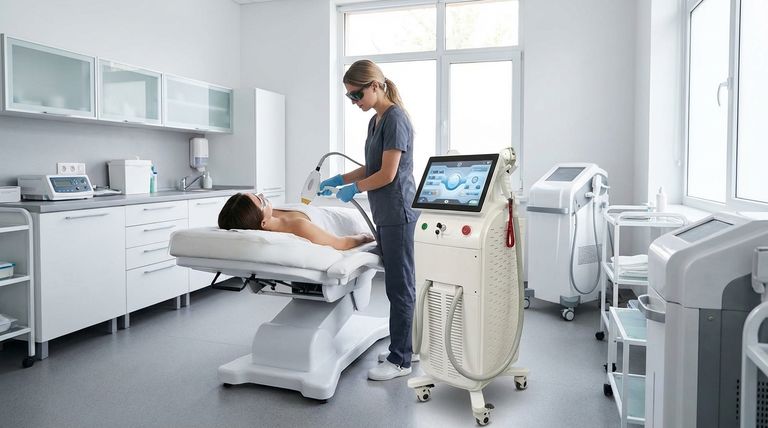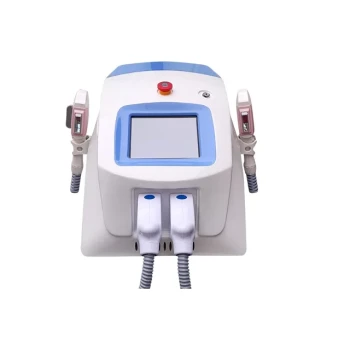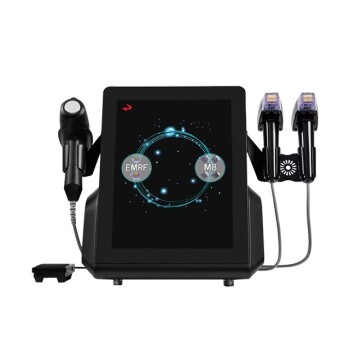In short, lasers are used in medicine to perform a vast range of treatments, from precise surgical cutting and vision correction to cosmetic procedures like hair removal, wrinkle reduction, and tattoo removal. They are also used in dentistry to remove decay and whiten teeth, and in vascular care to clear arteries or eliminate varicose veins.
The versatility of lasers in medicine comes not from a single type of treatment, but from their ability to function as a highly controllable energy source. By precisely tuning a laser's wavelength and power, it can be made to selectively cut, vaporize, or heat specific biological tissues while leaving adjacent areas unharmed.

How Medical Lasers Achieve Such Precision
The core principle behind most medical laser treatments is selective photothermolysis. This means using a specific wavelength of light (photo) to generate heat (thermo) that destroys (lysis) a chosen target, without damaging surrounding tissue.
The Role of Wavelength and a "Chromophore"
Every laser emits light at a single, specific wavelength. Different molecules in our body, called chromophores, absorb different wavelengths of light.
The key is to match the laser's wavelength to a chromophore that is abundant in the target tissue but absent in the surrounding tissue. The main chromophores in the body are water, hemoglobin (in blood), and melanin (in skin and hair).
Example: Laser Hair Removal
For hair removal, a laser is chosen whose wavelength is strongly absorbed by the melanin in the hair follicle. The light energy is converted to heat, which destroys the follicle and prevents future growth. The surrounding skin, which has less melanin, remains cool and undamaged.
Example: Treating Varicose Veins
To treat a varicose vein, a laser is used that targets hemoglobin within red blood cells. The laser heats the blood inside the unwanted vein, causing the vein wall to collapse and seal shut. The body then naturally absorbs the sealed vein over time.
Key Applications Across Medical Fields
The ability to target specific cells allows lasers to be used in nearly every field of medicine, each employing a different type of laser for its unique purpose.
In Surgery: The "Light Scalpel"
High-power lasers, such as CO2 lasers, are strongly absorbed by water, which makes up the vast majority of soft tissue. This allows surgeons to vaporize tissue layer by layer, effectively cutting or removing tumors with extreme precision and minimal bleeding, as the heat cauterizes blood vessels as it cuts.
In Dermatology: Resurfacing and Removal
Dermatology uses a wide array of lasers. Some are used for skin resurfacing, removing the outer layers of skin to reduce wrinkles and scars. Others, as mentioned, target melanin to remove unwanted hair or pigmented lesions, or target the ink pigments to break up and remove tattoos.
In Ophthalmology: Reshaping the Cornea
Laser-assisted in situ keratomileusis (LASIK) uses an "excimer" laser. This type of laser uses cool ultraviolet light to break molecular bonds and vaporize tissue without generating heat. This allows an ophthalmologist to precisely reshape the cornea to correct vision.
In Dentistry and Vascular Care
In dentistry, certain lasers can target and burn away the water and minerals in a cavity without the noise and vibration of a traditional drill. Other lasers are used for teeth whitening. In cardiology, they can be guided through catheters to vaporize plaque and clear blocked arteries.
Understanding the Trade-offs and Risks
While incredibly effective, laser treatments are not without important considerations. Their power and precision also create potential risks if misused.
Technology is Not One-Size-Fits-All
There is no single "medical laser." A laser designed to remove hair would be ineffective or dangerous for eye surgery. The success of a procedure depends entirely on selecting the correct laser for the specific target tissue and condition.
The Skill of the Operator is Critical
The effectiveness and safety of a laser treatment are highly dependent on the training and experience of the professional performing it. An improperly calibrated laser or an unskilled operator can cause burns, scarring, or changes in skin pigmentation.
Not All Conditions or People are Suitable
A person's skin type, the color of their hair or tattoo, and the nature of their medical condition determine if a laser is the right choice. For example, laser hair removal is typically most effective on dark hair and light skin, as this creates the highest contrast for the laser to target.
Making the Right Choice for Your Goal
Understanding the goal of the treatment is the first step in evaluating whether a laser is the appropriate tool.
- If your primary focus is cosmetic (skin, hair, tattoos): The key is to consult a board-certified dermatologist or plastic surgeon who can assess your skin type and choose the specific laser that will be safest and most effective for you.
- If your primary focus is surgical or dental: View the laser as an advanced tool your specialist may use to enhance precision, reduce bleeding, and potentially speed up recovery. Your decision should be based on the surgeon's expertise, not just the technology they use.
- If your primary focus is vision correction: A thorough ophthalmologic exam is non-negotiable to determine if you are a suitable candidate. Factors like corneal thickness and stability are paramount.
Ultimately, a laser is a sophisticated tool, and its true power lies in the hands of a skilled professional who knows precisely how to apply it to your specific needs.
Summary Table:
| Application | Primary Target (Chromophore) | Common Conditions Treated |
|---|---|---|
| Dermatology & Cosmetics | Melanin, Ink Pigments | Hair Removal, Tattoo Removal, Wrinkle Reduction, Pigmented Lesions |
| Surgery | Water in Soft Tissue | Tumor Removal, Precise Cutting with Minimal Bleeding |
| Ophthalmology | Corneal Tissue | Vision Correction (e.g., LASIK) |
| Dentistry | Water & Minerals in Teeth | Cavity Removal, Teeth Whitening |
| Vascular Care | Hemoglobin in Blood | Varicose Veins, Clearing Blocked Arteries |
Ready to integrate professional-grade laser technology into your practice?
BELIS specializes in providing advanced, reliable medical aesthetic equipment tailored for medical aesthetics clinics and premium beauty salons. Our expert team will help you select the ideal laser system to enhance your service offerings, improve patient outcomes, and grow your business.
Contact BELIS today for a personalized consultation and discover how our solutions can elevate your practice.
Visual Guide

Related Products
- Diode Tri Laser Hair Removal Machine for Clinic Use
- Trilaser Diode Hair Removal Machine for Beauty Clinic Use
- Clinic Diode Laser Hair Removal Machine with SHR and Trilaser Technology
- Diode Laser SHR Trilaser Hair Removal Machine for Clinic Use
- Multifunctional Laser Hair Growth Machine Device for Hair Growth
People Also Ask
- Does laser hair removal tighten your skin? The Truth About Collagen and Hair Removal
- Who is not suitable for laser hair removal? A Safety Guide to Assess Your Candidacy
- Does laser hair removal destroy stem cells? The Key to Permanent Hair Reduction
- How to get better results from laser hair removal? Achieve Smooth, Long-Lasting Hair Reduction
- How to get the most out of laser? Maximize Your Hair Removal Results Safely



















